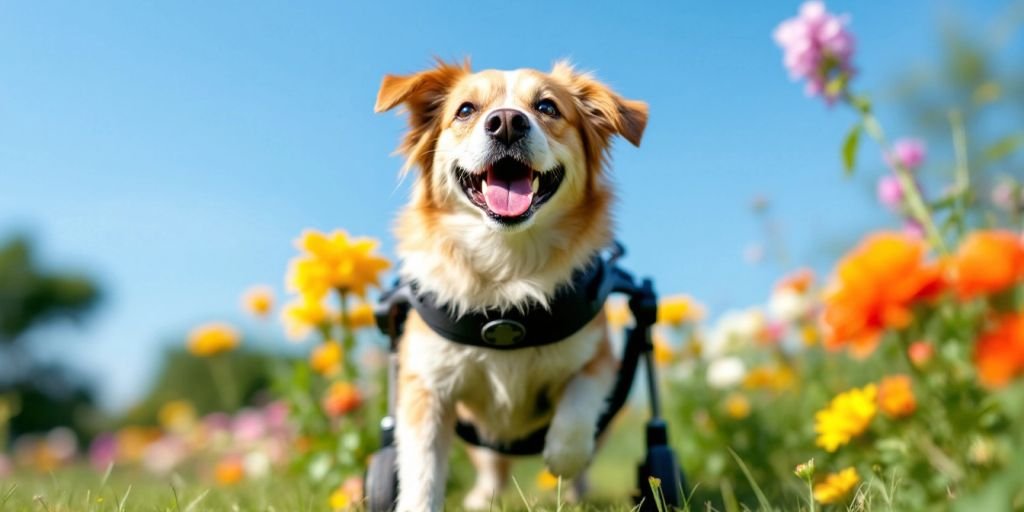Caring for dogs with special needs can be a rewarding yet challenging journey. These dogs often require extra attention and tailored support to help them thrive. Understanding their unique needs, providing the right tools, and creating a nurturing environment are essential steps to ensure they lead happy, fulfilling lives. This article explores various strategies to assist special needs dogs with mobility issues, helping them to stay active and engaged.
Key Takeaways
- Understanding your dog’s unique needs is the first step in providing proper care.
- Supportive devices like wheelchairs can greatly improve mobility and independence.
- Exercise routines should be adapted to each dog’s abilities, focusing on low-impact activities.
- A balanced diet and appropriate supplements can enhance your dog’s overall health.
- Training techniques should be adjusted to accommodate disabilities, using positive reinforcement.
Understanding the Unique Needs of Special Needs Dogs
Caring for special needs dogs requires understanding their unique challenges. Every dog is different, and recognizing their specific needs is essential for their well-being.
Consulting with Veterinarians and Trainers
One of the best ways to understand your dog’s needs is to consult with a veterinarian or a professional dog trainer. They can help you:
- Assess your dog’s strengths and weaknesses.
- Recommend suitable activities based on their abilities.
- Provide guidance on any medical concerns.
Identifying Physical and Emotional Requirements
Special needs dogs may have both physical and emotional needs. Here are some key points to consider:
- Physical Needs: Look for signs of discomfort or pain, and adjust their activities accordingly.
- Emotional Needs: Dogs may feel anxious or stressed; providing a calm environment can help.
- Social Needs: Interaction with other dogs and people can boost their confidence.
Creating a Safe and Stimulating Environment
A safe environment is crucial for special needs dogs. Here are some tips:
- Remove hazards that could cause injury.
- Provide comfortable resting areas, like orthopedic beds.
- Use supportive devices, such as harnesses or wheelchairs, to enhance mobility.
Creating a safe and engaging space allows your dog to explore and play freely, which is vital for their happiness and health.
By understanding these unique needs, you can significantly improve your dog’s quality of life, ensuring they thrive despite their challenges. Remember, patience and love go a long way in helping them feel secure and happy.
Supportive Devices for Enhanced Mobility
When it comes to helping special needs dogs, supportive devices can play a crucial role in enhancing their mobility and independence. These devices not only assist in movement but also boost the dog’s confidence and overall quality of life.
Choosing the Right Wheelchair
Selecting the right wheelchair for your dog is essential. Here are some key points to consider:
- Size and Fit: Ensure the wheelchair fits your dog properly to avoid discomfort.
- Material: Look for durable materials that can withstand daily use.
- Adjustability: Choose a wheelchair that can adapt as your dog’s needs change.
| Feature | Importance |
|---|---|
| Size | Comfort and mobility |
| Weight | Ease of use and transport |
| Durability | Long-lasting support |
Harnesses and Slings for Assistance
Harnesses and slings are great for providing extra support. They can help lift your dog when needed and assist them in navigating stairs or uneven surfaces. Here are some benefits:
- Easy to Use: Simple to put on and take off.
- Versatile: Can be used for various activities, including walks and bathroom breaks.
- Comfortable: Designed to distribute weight evenly, reducing strain on your dog.
Training Your Dog to Use Mobility Aids
Training is vital for your dog to feel comfortable using mobility aids. Here are some steps to follow:
- Introduce Gradually: Start by letting your dog explore the device without pressure.
- Positive Reinforcement: Use treats and praise to encourage your dog to use the aid.
- Practice Regularly: Consistent practice will help your dog become more confident.
Using supportive devices can significantly improve your dog’s quality of life, allowing them to enjoy activities they love.
By investing in the right supportive devices, you can help your special needs dog regain their independence and thrive in their environment.
Tailoring Exercise Routines for Special Needs Dogs
When it comes to keeping special needs dogs active, it’s essential to create exercise routines that cater to their unique abilities. Understanding your dog’s limitations is key to ensuring they stay healthy and happy.
Low-Impact Exercises for Joint Problems
- Swimming: A great way to exercise without putting stress on joints.
- Gentle walks: Short, slow-paced walks can help maintain mobility.
- Stretching: Simple stretches can improve flexibility and reduce stiffness.
Incorporating Mental Stimulation
Engaging your dog’s mind is just as important as physical activity. Here are some ideas:
- Puzzle toys: These can keep your dog entertained and mentally active.
- Scent games: Hide treats around the house for your dog to find.
- Training sessions: Short, positive training sessions can stimulate their brain.
Adapting Activities to Your Dog’s Abilities
Every dog is different, so it’s crucial to tailor activities to their specific needs. Here are some tips:
- Consult with a veterinarian: They can help assess your dog’s capabilities.
- Start slow: Gradually increase the intensity of activities as your dog becomes more comfortable.
- Monitor their response: Pay attention to how your dog reacts to different exercises.
Remember, the goal is to keep your dog active while ensuring their safety and comfort.
By focusing on low-impact exercises and incorporating mental challenges, you can help your special needs dog thrive. 🐾
Nutrition and Supplements for Special Needs Dogs

When caring for special needs dogs, nutrition plays a vital role in their overall health. A well-balanced diet can help support their bones, joints, and general well-being. Here are some key points to consider:
Special Diets for Bone and Joint Health
- High-quality protein: Essential for muscle maintenance.
- Omega-3 fatty acids: Help reduce inflammation and support joint health.
- Low-calorie options: Important for dogs with limited mobility to prevent obesity.
Supplements to Enhance Mobility
- Glucosamine and chondroitin: Commonly used to support joint health.
- Fish oil: Provides omega-3s that can improve mobility.
- Pet-Tabs Plus: A multivitamin and mineral supplement that supports general wellness, healthy skin, and coat, and helps correct nutritional deficiencies.
Consulting with Your Veterinarian
- Always consult your vet before making any changes to your dog’s diet or adding supplements. They can help tailor a plan that meets your dog’s specific needs.
A proper diet and the right supplements can significantly improve your special needs dog’s quality of life.
By focusing on nutrition and supplements, you can help your furry friend thrive despite their challenges.
Training Techniques for Dogs with Disabilities

Training dogs with disabilities requires special attention and care. Every dog is unique, and understanding their specific needs is crucial for effective training.
Using Hand Signals for Deaf Dogs
- Hand signals are essential for communicating with deaf dogs. Here are some tips:
- Use clear, distinct gestures for commands.
- Keep your hands visible and at the dog’s eye level.
- Practice consistently to reinforce learning.
Adapting Training for Blind Dogs
- For blind dogs, verbal cues and tactile signals are key. Consider these methods:
- Use consistent verbal commands for each action.
- Introduce textured mats to help them navigate.
- Employ scent markers to guide them around the house.
Positive Reinforcement and Rewards
- Positive reinforcement is vital for all dogs, especially those with disabilities. Here’s how to implement it:
- Reward your dog with treats or praise when they follow commands.
- Celebrate small achievements to build their confidence.
- Be patient; training may take longer for dogs with disabilities.
Training a dog with a disability can be challenging, but with patience and creativity, you can help them thrive.
By using these techniques, you can create a supportive environment that encourages learning and growth for your special needs dog. Remember, the goal is to help them lead a fulfilling life, regardless of their challenges.
Creating a Routine and Environment for Success
Establishing a Consistent Routine
Creating a daily schedule for your special needs dog is essential. A regular routine helps your dog feel secure and reduces anxiety. Here are some key components to include:
- Exercise: Short walks or gentle playtime.
- Rest: Designate cozy spots for naps.
- Feeding: Set specific times for meals.
Modifying Your Home for Accessibility
Your home should be a safe haven for your dog. Consider these adjustments:
- Use non-slip mats to prevent slipping.
- Provide ramps for easy access to furniture.
- Create multiple resting areas to ensure comfort.
| Feature | Purpose |
|---|---|
| Non-slip mats | Prevent falls |
| Ramps | Easy access |
| Orthopedic beds | Support joints and comfort |
Ensuring Regular Health Checks
Regular vet visits are crucial for monitoring your dog’s health. Schedule check-ups to:
- Assess mobility aids.
- Adjust medications if needed.
- Discuss any behavioral changes.
Remember, a safe and supportive environment is key to helping your dog thrive. By making these adjustments, you can enhance their quality of life and ensure they feel loved and secure.
Building Confidence and Quality of Life
Setting Realistic Goals
To help your special needs dog thrive, it’s important to set realistic goals. Here are some tips:
- Start small: Focus on achievable tasks that your dog can complete.
- Celebrate progress: Acknowledge every small victory to boost your dog’s confidence.
- Adjust as needed: Be flexible and modify goals based on your dog’s abilities.
Celebrating Small Achievements
Every little win counts! Here’s how to celebrate:
- Give treats: Use their favorite snacks as rewards.
- Praise them: Use a happy tone to encourage your dog.
- Playtime: Engage in fun activities they enjoy after achieving a goal.
Maintaining a Positive Attitude
Your attitude can greatly affect your dog’s mood. Here are some ways to stay positive:
- Stay patient: Understand that progress may be slow.
- Focus on the good: Highlight the positive aspects of your dog’s journey.
- Share experiences: Connect with other pet owners for support and encouragement.
Remember, disabled & handicapable dogs have just as much to live for. Adopting or fostering disabled pets is not for everyone, but the rewards can be immeasurable.
By following these steps, you can help your special needs dog lead a fulfilling life filled with joy and confidence!
Boosting your confidence can greatly improve your life. When you feel good about yourself, everything else seems easier. If you’re ready to take the next step towards a happier, more fulfilling life, visit our website for tips and resources that can help you on your journey!
Conclusion
In conclusion, helping dogs with mobility issues can truly change their lives for the better. By understanding their unique needs and providing the right support, we can help them enjoy a happier and more active life. Remember to be patient and positive, as every small step counts. With the right tools, like wheelchairs and harnesses, and a routine that includes fun activities, your special needs dog can thrive. Don’t hesitate to reach out for professional advice when needed. Together, we can ensure that our furry friends live their best lives, filled with joy and love.
Frequently Asked Questions
What are the common mobility issues in special needs dogs?
Special needs dogs often face problems like weak legs, arthritis, or injuries that make it hard for them to move around.
How can I help my dog adapt to using a wheelchair?
Start by letting your dog explore the wheelchair while it’s stationary. Gradually encourage them to use it for short distances, rewarding them with treats.
What types of exercises are safe for dogs with mobility issues?
Low-impact exercises like swimming or gentle walks are great. Always check with your vet for the best options.
Are there special diets for dogs with joint problems?
Yes, diets rich in omega-3 fatty acids and antioxidants can help. Consult your vet for a plan tailored to your dog’s needs.
How can I train a dog with disabilities?
Use positive reinforcement and adapt your methods to their abilities. For example, use hand signals for deaf dogs and verbal cues for blind dogs.
What should I do if my dog seems unhappy or in pain?
Keep an eye on their behavior and consult your vet if you notice changes. It’s important to address any discomfort quickly.




